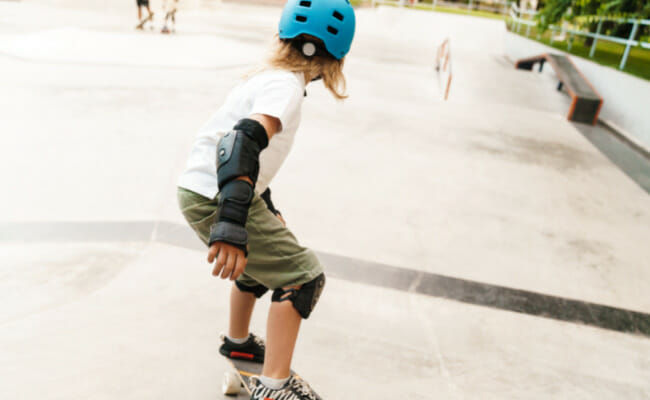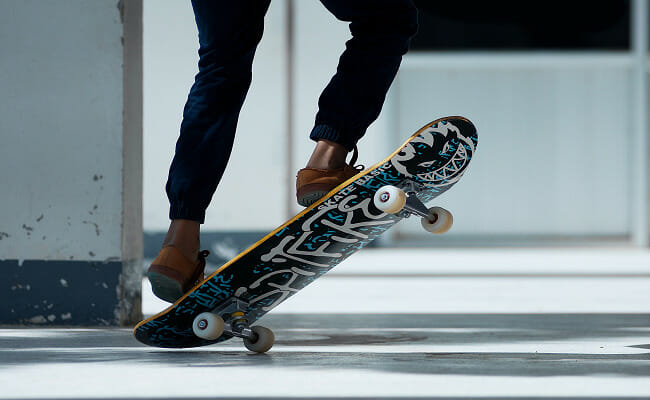Everything You Need to Know to Skateboard
So you want to learn how to skateboard? Great! Skateboarding is a lot of fun and a great workout too. But before you can start riding, there are a few things you need to know.
In this article, we’ll go over the basics – from choosing the right board, clothes, and gear to learning how to ride and keep your balance. By the end, you’ll be ready to hit the skatepark!
What you need to know about skateboarding

The fundamentals of skateboarding boil down to maintaining your balance and having fun! Learning how to steer your skateboard while maintaining balance is crucial. You learn by trial and error.
Wear proper shoes and socks
Buying quality skate shoes is vital. Get shoes with flat soles that can absorb impact. Absorbing shocks is crucial to prevent severe heel injury.
Additionally, it’s crucial that you can feel your board and that your shoes are flexible and hold on to grip tape on a skateboard. The function is better than the fashion style. Etnies, Vans, Emerica, etc., are some skate shoes to consider.
In addition, wear runner socks that absorb sweat, prevent blisters, and absorb shocks.
Wear protective gear
Beginners or even experienced skaters should wear safety gear such as helmets, wrist pads, knee pads, and elbow pads. You can get a protective set from a local skate shop.
Where to practice skateboarding
Skate parks are the best place to practice with your friends. Going early in the morning is a smart way to avoid crowds. If there is no local skate park close by, use a vacant parking lot or your driveway.
Different types of skateboards
Local skate shops offer a variety of skateboards; longboards, cruisers, and standards. There is a considerable difference between the three.
A regular board is best if you want to perform tricks. On the other hand, longboards and cruisers are excellent options for moving from place to place. Longboards are typically great for moving quickly. In addition, cruisers make long-distance travel easier, albeit they may not accelerate as soon as longboards.
For beginners to learn to skateboard, get an entire regular board. However, children will need smaller boards. Your height influences your ability to balance on the board. Shorter riders will probably need a narrower board. Pricewise, top-quality skateboards range from anywhere between $80 – 200.
Tips for beginners learning how to skateboard
1. Try to maintain your balance while standing
There is no correct way to stand on the board. Whichever foot you use, you can find your natural stance. Practice balancing and find your feet properly. Line up your feet roughly with the truck screws, lean forward and start skateboarding.
2. Try to move away
With your back foot, take a long, even step to build momentum as you stand on the board on level ground—practice pushing with your pushing foot or lead foot. Beginners have to push multiple times. An extended push-off can make the ride more comfortable.
3. Change into the riding position
When you start to move, change your riding feet sideways to closely resemble how you stood while the board was still on the grass. To learn how to balance correctly, bend your knees slightly. Note that you should generally be standing upright with a straight back.
4. Master turning
Whether you wish to turn right or left, you need to shift your weight forward or back from the ankle. If you want to spin at a slight angle, apply pressure on the back foot and lift the front wheels of the board.
Change into your riding stance. Put your foot forward, and then securely perform a turn. “Carving” is a popular style of turning. Push, keep practicing, and you’ll learn other tricks sooner or later.
5. Learn to stop.
The simplest method for a newbie is to tail stop or slow down gradually. Put your back foot down on the pavement, whether the left foot or right foot.
7. Learn how to fall properly
Nobody has ever skated without falling off the board. It could be frustrating when you fall. But developing proper fall techniques can help you avoid injuries. Protect your head by using a helmet and wrist guards. Wrist guards help cushion the painful scratches that are common in skating.
8. Skate with fellow skaters
Like learning music or other sports, learning to skate is made easier by having more experienced skaters around. Connect with more seasoned skaters to observe and learn tips. Be open and ask for some recommendations or advice.
9. Practice skating downhill.
When you start skating downhill, use gravity to your advantage. It could be a frightening experience for the first few tries. Eventually, you will learn how to deal with it and be more confidently in control of your board and your desired speed.
10. Learn basic and advanced tricks.
When you can stay on your board like most skaters, push yourself to learn new tricks., for instance, start with the ‘ollie,’ then do the ‘grinding,’ ‘pop shove’, and the kickflip next.
Conclusion
Skateboarding is a challenging and rewarding activity, but it can also be a lot of fun. Don’t be afraid to try new things – that’s how you progress as a skater. We hope this article has helped give you some ideas about what tricks to try next. But most importantly, always remember to wear your safety gear and stay safe while skating.
Frequently Asked Questions
Is skateboarding easy or hard? Skateboarding is challenging to learn. Just like learning how to surf, remember to keep your balance and manage your skateboard to avoid slip-ups. However, once you’ve learned the basics by heart, you can manage skateboarding tricks.
What is the easiest board to use? Skaters prefer to use the longboard since it is easier to navigate than a Penny board. Most often, people will use longboards for cruising and racing.






